| 0712Singapore
horse impaction colic, stomach tube, pet health and welfare educational for animal lovers,
excerpts from The
Glamorous Vets, Singapore, sponsored by AsiaHomes Internet. No second chance for the vet "The horse is still lying down and pawing," a worried Mr Bolkestein phoned me at 6 p.m on Labour Day. He always checked the horses before he went home although it was not his job as he was one of the private horse owners at this greenest and most picturesque and tranquil of al horse clubs in Singapore. "Threadneedle had been given the oil laxative five hours ago," I said. "He was also given stomach pain killers and antibiotics. Let the laxative work to loosen the constipated stools. Put him in a paddock and walk him a short while." 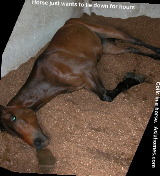 Mr Bolkestein had spotted this horse lying down in his stable for some
time and had called me quickly. This lanky teenager cared for all horses in the stables
and was a good volunteer help. Mr Bolkestein had spotted this horse lying down in his stable for some
time and had called me quickly. This lanky teenager cared for all horses in the stables
and was a good volunteer help. "Why don't you use a tranquiliser like the other veterinarian?" Mr Bolkestein had asked me when I struggled to restrain Threadneedle for stomach tube. He must be concerned about the horse suffering from being held in the ears by my assistant. Most horses disliked a stomach tube being inserted into his nostril to enter his stomach and would lift their heads up and away. "I had given the horse three injections for pain relief and infection," I explained. "The tranquiliser would be a fourth medication into his blood stream. This horse does not need a tranquiliser. It is exhausted and can be restrained with the twitch." Fortunately for me, I was proved right and the stomach tube went into the stomach at the second time. 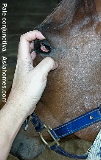 Now, the horse still had colic. Some horses had severe constipation and would not
respond immediately to the laxative. It would take around 24 hours for
the laxative to pass through the long gut of the horse. Mr Bolkestein had said that Threadneedle needed two stomach tubing in
the past.
Now, the horse still had colic. Some horses had severe constipation and would not
respond immediately to the laxative. It would take around 24 hours for
the laxative to pass through the long gut of the horse. Mr Bolkestein had said that Threadneedle needed two stomach tubing in
the past.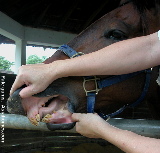 At 8 p.m, the stable manager phoned me to report that the horse was rolling, pawing the
grounds and not getting up. The horse's gut might be twisted and surgery would be
required. I asked him to observe the horse and called me if there were any
deterioration. There was no call from him.
At 8 p.m, the stable manager phoned me to report that the horse was rolling, pawing the
grounds and not getting up. The horse's gut might be twisted and surgery would be
required. I asked him to observe the horse and called me if there were any
deterioration. There was no call from him.The next morning, the stable instructor called to say that the horse had a rough night in the paddock. He saw some stools but it could be from other horses. This was bad news. Were the guts twisted? Would the horse die? 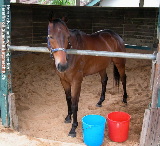 "Mak
Sallehs (Caucasians) always say colic when the horse lies down," Ramli said to me as
we drove up the hill to the paddock to look for Threadneedle under the blazing
sun. He was an experienced horse groomer or syce and had seen colic cases in the
turf club where he had worked. "The horse is tired and that why he lies
down." "Mak
Sallehs (Caucasians) always say colic when the horse lies down," Ramli said to me as
we drove up the hill to the paddock to look for Threadneedle under the blazing
sun. He was an experienced horse groomer or syce and had seen colic cases in the
turf club where he had worked. "The horse is tired and that why he lies
down." I did not know how he got this perception as many Caucasian riders are knowledgeable about equine colic and weariness. Threadneedle was standing looking like a war horse. Mud and sand caked his face and splattered over 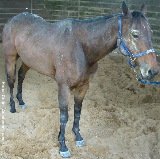 his body. At least he was standing and
interested in his surroundings. He was brought to the rolling box to be stomach
tubed. His rectal temperature was 38.5 degrees Celsius. This was normal. His stomach
looked distended a bit. The liquid paraffin laxative had worked through his
alimentary system as I saw the oil staining his anal area as I lifted his tail to take his
rectal temperature. his body. At least he was standing and
interested in his surroundings. He was brought to the rolling box to be stomach
tubed. His rectal temperature was 38.5 degrees Celsius. This was normal. His stomach
looked distended a bit. The liquid paraffin laxative had worked through his
alimentary system as I saw the oil staining his anal area as I lifted his tail to take his
rectal temperature.I gave Threadneedle his three painkiller and antibiotic injections and decided to stomach tube him again. 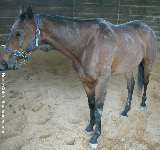 Ramli used the commercial horse twitch, a
metallic vice which clamped onto the horse nostril. The horse just lifted his head and the
vice fell off. Ramli used the commercial horse twitch, a
metallic vice which clamped onto the horse nostril. The horse just lifted his head and the
vice fell off. "Useless instrument," Ramli said. He preferred the baton with a rope. Most likely, the hand grip was not strong enough. With the baton, the restraint of the horse was much better. I tried to stomach tube via his right nostril for twenty times and his left nostril for ten times. The opening to his gut was just locked up. The tube could not enter it to get into the stomach. The tube entered the lung opening two times and Threadneedle reacted by lifting his head. This was unusual. A spasm of the pharyngeal muscles was the probable cause. "Must be feeling painful in the throat," Ramli said. It was 24 hours ago when the horse was stomach tubed. It was an easy procedure as I passed the tube in at the second try, so I did not think that the throat was inflamed. Many things about horse colic could not be explained satisfactorily. I mean, why would Threadneedle be having such a severe impaction colic when the other hundred horses were normal? Was he eating sand and wood shavings?  The horse just could not be stomach tubed. It would not give me a second chance. Perhaps I
should use a tranquiliser? Would a tranquiliser help?
The horse just could not be stomach tubed. It would not give me a second chance. Perhaps I
should use a tranquiliser? Would a tranquiliser help?I decided to stop to avoid traumatising the throat area and causing bleeding. I kept the horse in the rolling box for the rest of the day for observation. He drank water and looked normal. Horses do look normal after painkillers. He was his usual self the next morning with a trim tummy. He managed to escape from his stable, Ramli told me but he was caught fast. At least he was free from pain and was well loved and looked after in this beautiful riding club. |